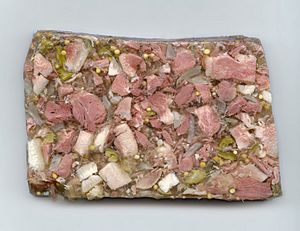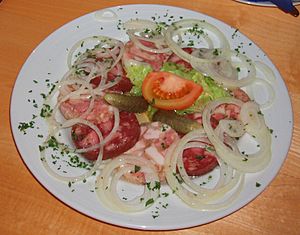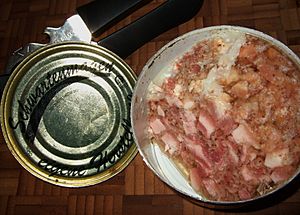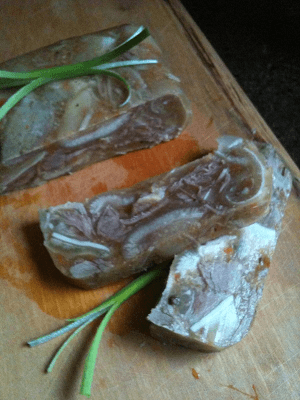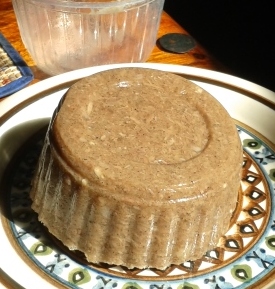Head cheese facts for kids
Head cheese (also known as brawn in some places) is a special kind of cold meat dish. It's like a meat jelly or a loaf of meat, often made from parts of a pig or calf's head. Don't worry, it's not actually a cheese! It gets its name because it's often shaped like a block, similar to how some cheeses look.
This dish usually comes from Europe and is eaten cold or at room temperature. The parts of the animal's head used can vary, but usually, the brain, eyes, and ears are not included. Sometimes, the tongue, feet, or heart are added. It can also be made from leftover meat trimmings from other parts of the animal. To make it hold its shape, gelatin is often used, or the natural gelatin from the meat itself helps it set as it cools.
Long ago, meat jellies like head cheese were common peasant foods, especially during the Middle Ages. They were made by simmering a cleaned animal head until the broth became naturally thick and jelly-like when cooled. Today, recipes might add extra gelatin to make sure it sets perfectly.
Contents
What it's Called Around the World
The name for this dish changes depending on where you are! In North America, it's called "head cheese." In Scotland, people call it "potted heid." In other parts of Britain and Australia, it's known as "brawn." If it's a pickled version (made with vinegar), it's often called "souse" in North America and the Caribbean.
Head Cheese in Different Countries
Head cheese is enjoyed in many ways all over the world, with each country having its own special recipes and ingredients.
Europe
In Austria, it's called Presswurst or Sulz. It's often served with a light dressing made of vinegar and oil.
In Germany, it's known as Sülze, Schwartenmagen, or Presskopf. You might find it in different colors, like deep red, pink, or grey, often shaped like a large sausage. Some versions have a tangy taste because of added pickles or vinegar. A special kind called Kaisersülze (Emperor's Aspic) is made with only the best meat.
In France and Belgium, it's called fromage de tête, which means "head cheese."
In Latvia, Galerts is a similar dish with meat in gelatin, often with vegetables like carrots. People sometimes add horseradish or vinegar when they eat it.
In Poland, the closest dish is salceson. It's traditionally put inside a pig's stomach or a cow's bladder. There are different kinds, like s. ozorkowy (with tongue) or s. włoski (spiced with garlic and fennel).
In Russia, head cheese is a popular food for celebrations. It's often called saltisón or kholodets.
In the United Kingdom, it's called "brawn" in England and Wales. In Scotland, it's known as potted heid.
Africa
In South Africa, it's called sult or "brawn" and is often flavored with curry.
Asia
In China, especially in the north, "pig head meat" is cooked, sliced thin, and served at room temperature. In northeastern China, a jellied pork skin dish is popular, served with a spicy sauce.
In Korea, a similar dish called pyeonyuk is made by pressing meat, usually from the pig's head. It's often eaten with alcoholic beverages or at feasts.
In Vietnam, around the New Year holiday Tết, people make giò thủ. It's a traditional snack made from pork belly, pig's ears, and spices, pressed into a mold until it sets.
Australia
In Australia, it's known as "brawn" or Presswurst. It's seen as a bit old-fashioned, but you can still find it in stores.
Caribbean
Souse is a pickled meat dish often made from pig's feet, chicken feet, or cow's tongue. The cooked meat is cut into small pieces and soaked in a brine with lime juice, cucumbers, hot pepper, and seasonings. It's a popular dish, especially on Saturday mornings in places like St. Vincent and Barbados.
Latin America
Head cheese is very popular in many Latin American countries. In Chile and Colombia, it's called queso de cabeza. In Peru, Ecuador, Bolivia, and Costa Rica, it's known as queso de chancho. In Brazil, it's called queijo de porco (pig cheese).
In Mexico, it's known as queso de puerco and is usually spiced with oregano, vinegar, garlic, and black pepper.
North America
In Pennsylvania, United States, people from the Pennsylvania Dutch community call it "souse." They often make it from pig's feet or tongue and pickle it.
In Louisiana, Mississippi, and Alabama in the Deep South, a highly seasoned version called "hog's head cheese" is very popular. It's a well-known Cajun food and often has green onions added.
In Newfoundland and Labrador, Canada, brawn is often made from wild game like moose and caribou.
See also
 In Spanish: Queso de cabeza para niños
In Spanish: Queso de cabeza para niños
Images for kids
-
Camembert, head cheese, and terrine de campagne


